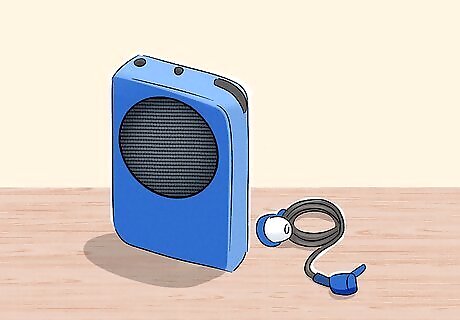
views
- Disguise your voice by holding your nose while speaking or using different facial expressions. You could also muffle your voice, mumble, or speak in a new accent.
- Use an app, computer software, or a novelty voice-changing device to make your voice sound different.
- Find out what you sound like to decide what you want to change. You could change your pitch or have a richer voice by projecting from your diaphragm.
- Take care of your vocal cords by avoiding alcohol, polluted air, and cigarette smoke. Practice signing often to keep your vocal cords in shape.
Disguising Your Voice

Hold your nose as you speak. A quick way to dramatically alter the sound of your voice is to block your nasal passages, and the easiest way to do this is to grasp your nose on either side and close off the nostrils. You can also accomplish a similar effect by simply blocking breath from entering your nose through the mouth. As you speak, airflow naturally travels through both your mouth and nose. Blocking off your nose restricts the amount of air that escapes through your nasal passages and causes more air to be trapped deeper in your throat and mouth. This change in amount and pressure causes your vocal cords to vibrate differently, which changes the way your voice sounds.

Speak with a different expression. Try speaking while smiling or speaking while scowling, regardless of what you actually say. Expression can affect the emotion with which words are spoken, but expression also changes the formation of your words because your mouth is held in a different position. For instance, consider how the word “oh” sounds when you smile versus how it sounds when your face remains loose. A loose “oh” is more rounded, while an “oh” spoken through a smile will sound shorter in comparison and may even resemble the “ah” sound.

Muffle your voice. Place your hand or a handkerchief over your mouth as you speak. The obstacle should be directly against your mouth to produce a more dramatic effect. Your voice, like any sound, travels through various mediums in the form of sound waves. The way that those waves are transmitted through air differs from the way those waves sound when traveled through a different medium, like a solid. By placing a solid obstacle in front of your mouth as you speak, you force the sound waves through that obstacle, thereby changing the way that others' ears hear and interpret the sound.

Mumble. When you speak, do so in a quieter tone and open your mouth less as you pronounce words. Mumbling changes both word formation and the manner in which your voice carries. When you mumble, you keep your mouth more closed than usual. Certain sounds are pronounced while the mouth is only slightly opened, and those will not be affected much. On the other hand, sounds that naturally require you to open your mouth significantly more will be greatly altered. Consider the difference in sound when saying something as simple as “oh.” First, say “oh” while opening your mouth wide open. Then, repeat the “oh” syllable while keeping your lips just barely parted. If you listen carefully, you should notice the difference in sound. Mumbling also causes you to speak softer. Clear, middle sounds may come through well enough when you speak softly, but softer sounds and end sounds tend to be obscured. Consider the difference in sound when repeating a simple phrase like “got it.” Repeat the phrase forcefully in your normal tone. You will likely be able to pick up on the ending “t” sounds, even if the “t” at the end of “got” blends into the next word. Then, try repeating the phrase weakly in a quiet tone. The two vowel sounds will likely be audible, but the “t” sounds should have weakened significantly.

Speak in monotone. Most people naturally speak with some degree of emotion. Focus on maintaining a flat, consistent tone of voice as you speak. The less emotion you use while speaking, the more different your voice will sound. The easiest way to notice the difference is by asking a question in monotone. When asking a question, the vast majority of people will end with a higher intonation. The same question can sound much different when spoken in a flat voice, without that final shift in tone. Alternatively, if people tend to say that you have a flat voice, practice speaking with more enthusiasm or emotion. Think carefully about what you say and change your intonation as you speak accordingly. A good way to practice is with a simple phrase like “Yeah.” When someone says “yeah” in a hurt way, there should be a downward shift in intonation. On the other hand, an enthusiastic “yeah” will have a strong tone with a somewhat high pitch from start to finish.

Practice a new accent. Pick an accent that fascinates you and study the way that it varies from your own way of speaking. Each accent is a little different, so you will need to thoroughly familiarize yourself with the quirks of each individual accent before you can speak in that accent convincingly. Non-rhoticity is a common feature of several accents, including the Boston accent and many British accents. Non-rhoticity refers to the practice of dropping the final "r" sound from a word. For example, "later" would sound like "lata" or "butter" would sound like "butta." The "broad A" is another common feature of many accents, including many British accents, Boston accents, and accents found in English-speaking countries in the Southern Hemisphere, including New Zealand, Australia, and South Africa. This practice involves lengthening the short "a" sound. Use simple tricks for vocal improvement. "I've never liked hearing recordings of my own voice. After reading this article, I tried little things like smiling or frowning as I spoke to change my tone. It felt funny at first, but I had a blast making faces while talking! My voice now has a brighter, peppier vibe that makes me way more pumped to speak up." - Kevin W. Become an amateur voice actor. "I decided to tap into my dramatic side with this guide. Mimicking accents and recording myself was a blast, even when I sounded totally goofy. Trying on different dialects helped me control my vocal pitch and projection better. My new party trick is nailing impressions of celebs with unique speech patterns." - Roslyn B. Rediscover your inner child's voice. "Over time, my voice lost the high, sweet pitch I had as a kid. Rereading this article, I attempted tricks like smiling while I talk to alter the actual sounds. I also listened back to recordings of my younger self to compare and practice matching that tone. It took some effort, but I regained a more youthful, melodic quality." - Abigail C. Steadily build vocal confidence. "I used to get super nervous speaking up in groups. Looking back at this guide's tips on breath support and projection has boosted my confidence. Doing regular voice exercises expanded my range. Now, I happily volunteer for presentations at work, knowing my voice comes across as clear and assured." - George N. We want to hear from you! Advice from our readers makes our articles better. If you have a story you’d like to share, tell us here.
Using Technology to Change Your Voice

Find an app on your smart phone. Downloadable voice changer apps allow you to record your voice into your cellphone and play the words back using a filter that alters the sound of your voice. There are many different apps available. Some cost money, but others are free. Check for apps through the Apple App Store iPhone, Windows Marketplace if you have a Windows phone, or Google Play if you have an Android.

Speak through computer software. Search for downloadable text-to-speech freeware or software online. Once installed, type your words into the software text box and press the "Play" option to play your written words back using audio.

Use a novelty voice changer. Voice changing devices can be difficult to locate in stores, but you can easily find a novelty device for purchase online. A standard novelty voice changer ranges in price from $25 to $50. Each device works differently, so you should check out the specifications to know what you are getting. Most grant you the ability to change the pitch of your voice in different ways, and many novelty devices are portable. Some devices require you to pre-record your message, but others can be used to adjust your voice as you speak, transmitting the altered through a cell phone or other speaker. Carefully read the instructions that come with your novelty voice changer to learn how to use it properly.
Changing the Way You Talk

Figure out what you sound like. If you want to change your voice to make it sound either higher or deeper, start by recording yourself so you'll know what approach to take. Use a recording device to capture the sound of your voice talking quietly, talking loudly, and singing. How would you describe the sound of your voice? What would you like to change? Does your voice sound nasally or gravelly? Is it easy or difficult to understand what you're saying? Is your voice breathy or clear?

Stop talking through your nose. Many people have a voice that can be described as "nasally." A nasally voice tends to sound unnaturally higher than it should, because it doesn't have a chance to resonate properly to produce a deeper tone. This type of voice can sound grating to others as well as being difficult to understand. Make the following changes to eliminate that nasally sound: Make sure your breathing passages are clear. If you tend to have allergies or your nose is often clogged for other reasons, your voice is going to be stunted and nasally. Clear up your allergies, drink plenty of water and try to keep your sinuses clear. Practice opening your mouth wider when you speak. Drop your jaw and enunciate your words lower in your mouth, rather than producing them in your soft palate.

Don't speak from the back of your throat. In order to correct a high voice, many people speak from the back of their throat to produce a falsely deep tone. It's hard to get the proper amount of volume when you're straining to speak from the back of your throat, so doing this produces a muffled, difficult-to-interpret voice. In addition, speaking from the back of your throat in an attempt to sound as though your voice is deeper than it really is puts strain on your vocal cords and can cause a sore throat and voice loss over time. Try doing breathing exercises and exercises that will open up your voice. That can help you use more of the full range of your voice.

Speak through your "mask". In order to make your voice sound deeper and more full, it's necessary to speak through your "mask," which is the area comprised of both your lips and nose. Using your entire mask to speak gives your voice the best chance of sounding a bit lower and richer. To determine whether you're speaking through your mask, touch your lips and nose as you speak. They should vibrate if you're utilizing the entire area. If they don't vibrate at first, experiment with different sounds until you find a way of speaking that works, then practice speaking that way all the time.

Project from your diaphragm. Breathing deeply and projecting from your diaphragm is key to having a full, rich, strong voice. When you're breathing deeply, your stomach should move in and out with each breath, rather than your chest rising and falling. Practice projecting from your diaphragm by pulling your stomach in to exhale as you speak. You'll notice that your voice rings out loud and clear when you breathe this way. Doing breathing exercises in which you focus on deep breathing will help you remember to project from your diaphragm. Exhale, pushing all the air from your lungs. Once your air runs out, your lungs will automatically begin to inhale deeply in an attempt to satisfy your need for air. Pay close attention to how your lungs feel when you take a deep breath. Inhale comfortably and hold your breath for 15 seconds before exhaling. Gradually increase the amount of time you hold your breath to 20 seconds, 30 seconds, 45 seconds, and 1 minute. This exercise strengthens your diaphragm. Laugh heartily, purposefully making a "ha ha ha" sound. Expel all the air from your lungs with your laugh, then inhale deeply and quickly. Lie on your back and place a book or solid object on your diaphragm. Relax as much of your body as possible. Pay close attention to the movement of your diaphragm, noting how the book rises and falls as you breathe. Flatten your stomach as much as possible when you exhale, and repeat until you automatically expand and contract your waist with each breath. Inhale deeply while standing. Exhale, counting aloud from one to five with a single breath. Repeat the exercise until you are able to comfortably count from 1 to 10 on one exhale. When you get the hang of speaking this way, you should be able to project so that your voice can be heard by people on the other side of the room without causing you to become hoarse.

Change your pitch. The human voice is capable of producing sound in a range of pitches. Speak in a pitch higher or a pitch lower to temporarily change your voice. Pitch is altered in large part by the laryngeal cartilage. This is the movable piece of cartilage that rises and falls in your throat as you sing a scale: doh, re, mi, fa, sol, lah, ti, doh. Raising the laryngeal cartilage raises your pitch and creates a more feminine sound. Dropping the laryngeal cartilage drops your pitch and creates a more masculine sound. To speak in a lower voice, do exercises to relax your throat, like yawning or opening your mouth really wide from top to bottom. When you open your mouth, you'll notice that your voice is much more rounded, resonant, and deep.
Bringing Out the Best in Your Voice

Take care of your vocal cords. Your vocal cords, like your skin, need to be protected so they don't age prematurely. If you're hard on your vocal cords, your voice could end up sounding gravelly, whispery, or otherwise unpleasant long before its due. To protect your vocal cords, take the following measures: Don't smoke. Smoking cigarettes has a very pronounced effect on the voice, causing it to lose volume and range over time. If you want your voice to stay clear and strong, it's best to quit. Cut back on drinking. High alcohol intake can also cause your voice to age prematurely. Try to breathe clean air. If you live in a polluted area, load your house with plants to clean the air, and try to get away from the city to breathe fresh air as often as possible. Don't scream too much. If you're a huge fan of hardcore music or you just enjoy screaming sometimes, be aware that using your voice in this way can strain it. Plenty of singers have experienced laryngitis and other vocal maladies from overusing their vocal cords.

Examine your stress level. When we experience stress or surprise, the muscles surrounding the larynx contract and cause a high-pitched voice to emerge. If you're constantly nervous, anxious and stressed out, this higher pitch might be your everyday voice. Take measures to calm yourself down so that your steady, full voice is able to emerge. Try taking a few deep breaths before you speak. In addition to calming you down, this will gear you up to project from your diaphragm, improving the sound of your voice. Take 10 seconds to think before you react. When you allow yourself time to gather your thoughts before reacting in nervousness or surprise, you have greater control over your voice. Think, take a swallow, then speak - you'll find that your voice comes out more steady and relaxed.

Practice singing. Singing alongside instrumental or vocal accompaniment is a good way to increase your pitch range and keep your vocal cords in good shape. Similarly, you could practice singing along to songs that are outside of your usual vocal range. Each time you sing along, match the notes and pitch of the original singer as closely as possible without straining your voice. With piano accompaniment, begin singing a scale: doh, re, mi, fa, sol, lah, ti, doh. Start at the most comfortable, natural pitch possible. Repeat the scale, increasing your starting pitch by one note each time until your voice begins straining. Once your voice begins to strain, stop. Repeat the scale again, decreasing your starting pitch by one note each time and stopping once your voice begins to strain. Keep your throat relaxed to make it easier to create lower tones.

















Comments
0 comment